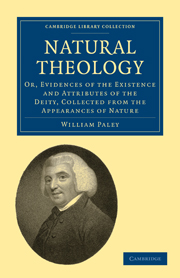 Natural Theology
Natural Theology Published online by Cambridge University Press: 07 September 2010
It is not that every part of an animal or vegetable has not proceeded from a contriving mind; or that every part is not conftructed with a view to its proper end and purpofe, according to the laws belonging to, and governing, the fubftance or the action made ufe of in that part; or that each part is not fo conftructed, as to effectuate its purpofe whilft it operates according to thefe laws: but it is becaufe thefe laws themfelves are not in all cafes equally underftood; or, what amounts to nearly the fame thing, are not equally exemplified in more fimple proceffes, and more fimple machines; that we lay down the diftinction, here propofed, between the mechanical parts, and other parts of animals and vegetables.
For inftance; the principle of mufcular motion, viz. upon what caufe the fwelling of the belly of the mufcle, and confequent contraction of its tendons, either by an act of the will or by involuntary irritation, depends, is wholly unknown to us. The fubftance employed, whether it be fluid, gafeous, elaftic, electrical, or none of thefe, or nothing refembling thefe, is alfo unknown to us: of courfe the laws belonging to that fubftance, and which regulate its action, are unknown to us. We fee nothing fimilar to this contraction in any machine which we can make, or any procefs which we can execute.
To save this book to your Kindle, first ensure [email protected] is added to your Approved Personal Document E-mail List under your Personal Document Settings on the Manage Your Content and Devices page of your Amazon account. Then enter the ‘name’ part of your Kindle email address below. Find out more about saving to your Kindle.
Note you can select to save to either the @free.kindle.com or @kindle.com variations. ‘@free.kindle.com’ emails are free but can only be saved to your device when it is connected to wi-fi. ‘@kindle.com’ emails can be delivered even when you are not connected to wi-fi, but note that service fees apply.
Find out more about the Kindle Personal Document Service.
To save content items to your account, please confirm that you agree to abide by our usage policies. If this is the first time you use this feature, you will be asked to authorise Cambridge Core to connect with your account. Find out more about saving content to Dropbox.
To save content items to your account, please confirm that you agree to abide by our usage policies. If this is the first time you use this feature, you will be asked to authorise Cambridge Core to connect with your account. Find out more about saving content to Google Drive.